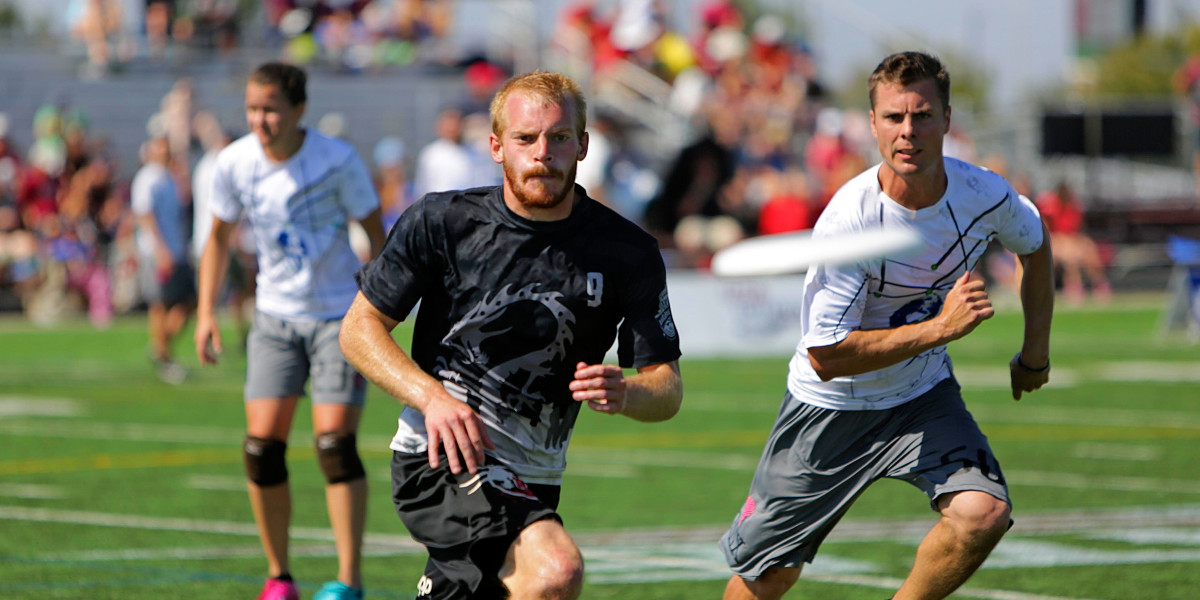
What is interval training?
Interval training, a type of conditioning that alternates periods of work and rest, can be used as an effective way to get in shape for the ultimate season. In order to train efficiently, it’s helpful to understand the basic science behind your workout regime.
Many ultimate players want to increase how far and how fast they can run. This skill depends on the body’s ability to resupply energy to the circulatory system and muscles over an extended period of time, otherwise known as cardiovascular endurance.
The quickest way to improve your cardiovascular endurance is to train at a speed where your body uses the most oxygen it can, which is known as your VO2 max. This training speed can be maintained for about six minutes, but no longer.
When training at levels lower than your VO2 max, more than 90% of the energy required for the work you are doing is generated by the aerobic system. As the intensity (speed) of work increases above the VO2 max, the percentage of aerobic (versus anaerobic) metabolism decreases.
The greatest increases in cardiovascular fitness will occur by working out at an intensity near your VO2 max. The problem with training near your velocity at VO2 max is that it generates fatigue via acid buildup in the muscles.
To avoid lactic acid buildup, we would have to train at an intensity where only the aerobic system is used. This is a speed that can be maintained indefinitely, like the one you would use on a long-distance run. This pace would correspond to only about 80% of your VO2 max, which does not increase your cardiovascular fitness as rapidly as working out at higher intensities.
So how do we work out at an intensity that uses the maximum amount of oxygen without tiring out from lactic acid buildup? This is where interval training comes in. With interval training, you can extend the amount of time you spend using your VO2 max with significantly less lactic acid buildup in the muscles.
Examples of interval workouts
There are many variables to play with when designing an interval training session or program. You can vary the intensity and length of the work, the length of the rest interval, the number of repetitions, and what you’re doing in your rest interval. With all of these variables to consider, there are many ways to design an interval workout.
Here are four examples to try that are practical for ultimate players. All workouts are preceded by a dynamic warmup.
- The 30/30 workout.
- Run 30 seconds at your timed mile pace
- Walk 30 seconds
- Repeat 15-30 times; 2 repetitions a week
Tips:
This is a great workout for ultimate players who really like long distance running and like the feel of longer workouts.
- The 80/20 workout.
- Run 20 seconds at 80% sprint speed
- Walk 40 seconds
- Repeat 8-20 times
Tips:
The running pace should feel like a swift run, but not a sprint. Your feet will hit the ground at the midfoot. Start with 8-10 repetitions and add 2 each week. This workout can be done frequently, up to three times per week. Keep the volume at an amount that you can completely recover from by the next workout.
- Speed Endurance Intervals
- Move 30 seconds at 100% effort
- Rest 90 seconds
- Repeat 3-9 times
Tips:
These intervals are done at higher intensity but with longer rest periods. I often do these types of intervals as part of a nonlinear workout. So not only the movements, but also the intensity of movement more closely reflect what I want to happen on the field. After the rest intervals of 60-90 seconds, your breathing should nearly be recovered.
This is a great type of conditioning to use with teams after a practice. To get in a higher volume of training, a good format to use is four repetitions, 2-4 minutes of rest, and a second set of four repetitions using a different movement or exercise.
The Cutting Tree
Love this idea from Michael Caldwell. This is very sport-specific training. It requires some self-discipline and visualization. It is an excellent idea ideally reserved for the motivated individual or a small group.
Whether you’re gearing up for the club season or for summer league I hope you’ll give interval training a try! Design your own or get the whole six week system here.










Comments Policy: At Skyd, we value all legitimate contributions to the discussion of ultimate. However, please ensure your input is respectful. Hateful, slanderous, or disrespectful comments will be deleted. For grammatical, factual, and typographic errors, instead of leaving a comment, please e-mail our editors directly at editors [at] skydmagazine.com.